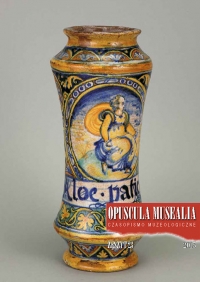Konserwacja obrazu Bernardo Strozziego „Trzej fi lozofowie” – depozytu w Muzeum Narodowym. Próba rozpoznania repliki autorskiej lub kopii warsztatowej na podstawie badań z wykorzystaniem promieniowania rentgenowskiego
Conservation of the painting by Bernardo Strozzi “Three Philosophers”, on loan in the National Museum. An attempt at establishing whether it is an author-made replica or a workshop-made copy, based on X-ray examination
Author(s): Katarzyna Semkowicz-NovljakovićSubject(s): Museology & Heritage Studies, Visual Arts, 17th Century, Sociology of Art
Published by: Wydawnictwo Uniwersytetu Jagiellońskiego
Keywords: Bernardo Strozzi; art restoration; Italian paintings of 17th century; technology research; X-ray application in technology research of old masters’;
Summary/Abstract: The painting Three Philosphers by Bernardo Strozzi (1582–1644), also known as Il Cappuccino or Il Prete Genovese, is one of the few works by that artist in Polish collections. He was active in Genoa in the first half of the seventeenth century and is regarded one of the most prominent Italian artists of the early baroque era. His paintings and those attributed to his studio can be seen in major museums all over the world. Currently work on the corpus of Bernardo Strozzi’s works is underway, because the importance of his oeuvre is now increasingly widely recognised and the specificity of his painting in the seventeenth-century Italy appreciated. Three Philosophers in the National Museum in Krakóws is a replica of the painting now in the private collection of the Palazzo Catteneo Adorno w Genoa. Conservation of the painting was made using physico-chemical analysis, including the testing of elemental composition with the use of non-destructive X-ray fl uorescence spectroscopy, and in particular the analysis of X-ray pictures, which helped to retrace the process of painting. The tests were carried out in the Laboratory of Analysis and Non-Destructive Investigation of Heritage Objects at the National Museum in Kraków. X-ray pictures were made using the DIX-Ray digital radiography system using the DixRay Flecible FPS 9 detector (dimensions: 46X38 cm) and the Orange 1060HF lamp. The lamp was set at: 40kV, 12mAs. In view of the size of the painting, to cover the entire painting, individual pictures were put together using Photoshop CS6 The high quality of the digital X-ray picture made it possible to identify successive phases of the artist’s work: from the preparation of the painting support, through the fi rst composition made in the washing technique for udnerpainting, with visible changes in drawing details, to the proper painting layer with legible individual gestures of the painter. Stratigraphic tests along with the analysis of binding media in the painting layers were carried out in the Faculty of Art Conservation and Renovation of the Academy of Fine Arts in Kraków, providing important information for the study of the painting. Stratigraphic tests and the X-ray spectrometry method tests with energy dispersion using a scanning electron microscope with a radiation energy spectrometer (EDS) revealed the following pigments: lead white, natural yellow ochre, organic red, vermillion, red ochre, vegetable black. Bole ground was identified in which the presence of lead white, vermillion and vegetable black was recorded. The SEM/EDS using X-ray showed substantial amounts of silicon and aluminium in the mixture of pigments in the painting layer, which means that aluminosilicates were used as fillers in paints. The results were compared with the only analysis of a painting by Strozzi in Polish collections – Visitation from the National Museum in Warsaw. The data collected and their interpretation allow the hypothesis that the painting is a replica by Bernardo Strozzi himself of his painting Three Philosophers from the Palazzo Catteneo Adorno collection in Genoa.
Journal: Opuscula Musealia
- Issue Year: 2015
- Issue No: 23
- Page Range: 101-111
- Page Count: 11
- Language: Polish

